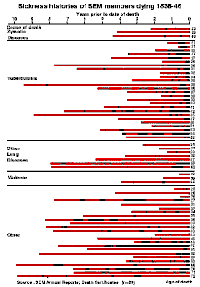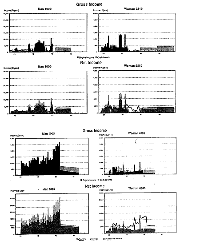|
Editorial
Abstract
Introduction
Visualising Mobility
Visualising transitions
Visualising trajectories
Discussion
Conclusions
Acknowledgements
References
Case Studies Index
|
Mapping the Life Course:
Visualising Migrations, Transitions &
Trajectories
3. Visualising other Transitions in individual lives

The above examples all concern transitions between places or trajectories
through space, but similar methods are applicable to other dimensions of the
life course. The Figure 6 shows a series of possible transitions which can
affect the individual worker, reducing their productivity and increasing
demands on welfare systems; note that the only transition out of
superannuation is death and that there are no transitions from death. The
Steam Engine Makers (SEM) database, used above to study migration, records all
these transitions for this particular group of C19 workers. The Figure 7 (from
Southall & Garrett, 1991) shows the sickness histories for SEM members;
note that time can be expressed in three ways: years from birth, indicated by
the ages on the right-hand margin; years before death, shown on the horizontal
axis; and, missing here, the actual calendar date. One rather obvious comment
about what this figure shows is that men who died of TB tended to be sick for
lengthy periods prior to their deaths, while those dying of `violence' (mainly
industrial accidents) experienced little prior sickness.
Other studies taking similar approaches are Savage (1993) on the career paths
of banking workers, which he uses to explore gender differences and the
emergence of the `modern career', and Alter (1988) on the linked migratory and
fertility histories of Belgian women. These examples are all `historical', but
to some extent any study of lives as a whole must span decades. The issues
addressed by such life-course research are of great contemporary significance;
for example, Falkingham & Hillis (1995) in ESRC-funded research explored
the relationship between variations over the life-course and between lives in
net benefits from state welfare systems. Differences between lives are
critical, but their presentation is limited to just four samples as shown in
Figure 8.
Figure 7: Sickness histories of SEM members dying
1838-46

Figure 8: Gross and Net Lifetime Incomes for Two Simulated Couples

(source Falkingham & Hillis, 1995 pp.78 and 80).
The above graphs concern not real people but sample output from
micro-simulation models. The horizontal axis is years from birth and the
vertical axis is income, either from work (in black) or from benefits (in
grey). For example, man 1000 (at top right):
"has a poor employment record. He leaves school at 16, and being
unable to find regular employment, receives Supplementary Benefit (SB) from age
16 to 20. Because of his interrupted work history he only receives Unemployment
Benefit in the years when he is 23 and 24 (during which entitlement runs out)
and when he is 38; at all other times when he is out of the labour market he is
reliant on SB. The only time he pays significant amounts of tax, reducing his
net income [lower graph] below his gross income [upper graph] is during his
mid-30s". Conversely, man 1065 (at bottom right) remains in
full-time education to age 20 but then receives a much higher income until
retirement at age 65 (see Falkingham & Hillis, 1995 pp.77-82).
|



